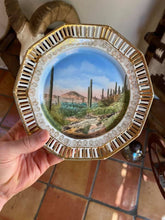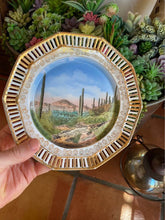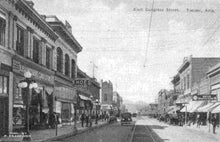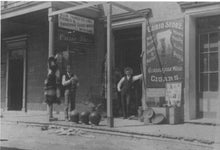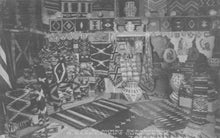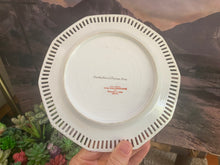
This is an absolutely stunning piece from Rasmessen's Curio in Tucson, Arizona Territory. These plates were often sold to tourists and represents the early beginnings of marketing Arizona and the greater Southwest. Rudolf Rasmessen would later become the mayor of Tucson from 1921-1925. We have included a fascinating bio below to provide a more in depth perspective to his local contributions.
“Rudolf Rasmessen was born in 1875, in Malmo, Sweden, the eldest child of Anders and Elsa Rasmessen. The family immigrated to the United States settling in Chicago, when he was just five years old. After graduating from high school, and working his way up from mail boy to neckwear salesman at a local store. Rudolf was struck with typhoid fever. Like so many others at the time, he came to Arizona to recover his health. Accompanied by his future brother-in-law, Otto Anderson. Rudolf arrived in Tucson in 1898, with letters of introduction to department store owner Albert Steinfield and mining engineer L.D. Chilson. He planned to stay six weeks. Rasmessen arrived at a time of change that had begun with the arrival of the railroad in 1881. Tucson was turning it’s back on its Sonoran roots and transforming itself into an American town. The city’s Chamber of Commerce was just two years old in 1898, the Tucson Opera House had been open only three years, and the arrival of the first automobile was two years in the future. The first mule drawn street cars were pushing city expansion to the east and west. New buildings dotted the landscape- the St Augustine Cathedral (1897), the Carnegie Library (1901), the Santa Rita Hotel (1904), and others. For a businessman, Rasmessen’s timing could not have been better. Shortly after his arrival, Rudolf became partners with Sam Baumann in managing a curio store. Both men were in their early twenties and just starting out in business. Their store, which catered to tourists, new residents, and native Tucsonans alike, played a distinctive role in promoting the community as a good place to live. Curio stores, selling Indian goods and souvenirs, were a new and popular business, partly because of the interest generated by displays and archeological fairs and exhibitions around the country. Rudolf and Sam learned the business from Sam’s father, John Baumann, a former Navajo Indian agent and Indian trader. In just a few years, Sam left the business and Rasmessen continued as the sole owner. Rudolf made regular trips through Tohono O’odham and Navajo reservations, by wagon and later by automobile, buying blankets, baskets, and pottery for the store. Coinciding with Rasmessen’s new business interest and his growing civic involvement was the rapid growth in popularity across the country of photographic post cards. The U.S. Post Office had recently established a reduced rate for post cards, daily mail service now extended to rural areas, and Kodak had begun making post card size photographic paper. At the same time, Americans were on the move- for their health, for work, for school, and as tourists. During the heyday of the photo postcard’s popularity, newcomers to Arizona regularly sent brief notes to their friends and loved ones, updating them on their health, job prospects, and activities. Others exchanged mail with fellow postcard collectors. Most families had a postcard album at home and enthusiasts were caught up in the collecting mania of the time. Rasmessen began publishing and selling photo postcards at his Curio Store in 1905. He carefully selected photographs (which he is not believed to have taken himself), depicting modern public buildings, homes, streets, and scenic views, presented Tucson at its best. Rudolf Rasmessen, whose career was spent promoting Tucson as a businessman and private citizen was elected Mayor of Tucson from 1921-1925.”











